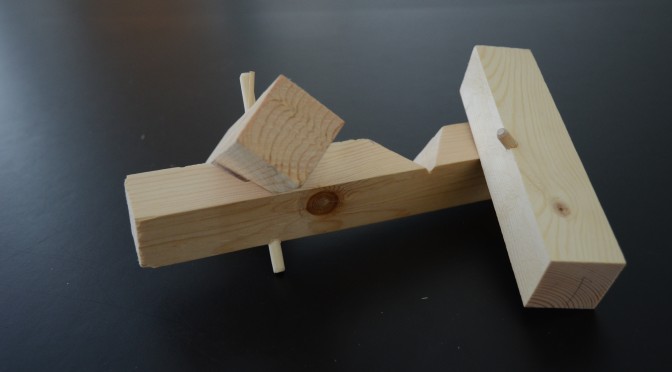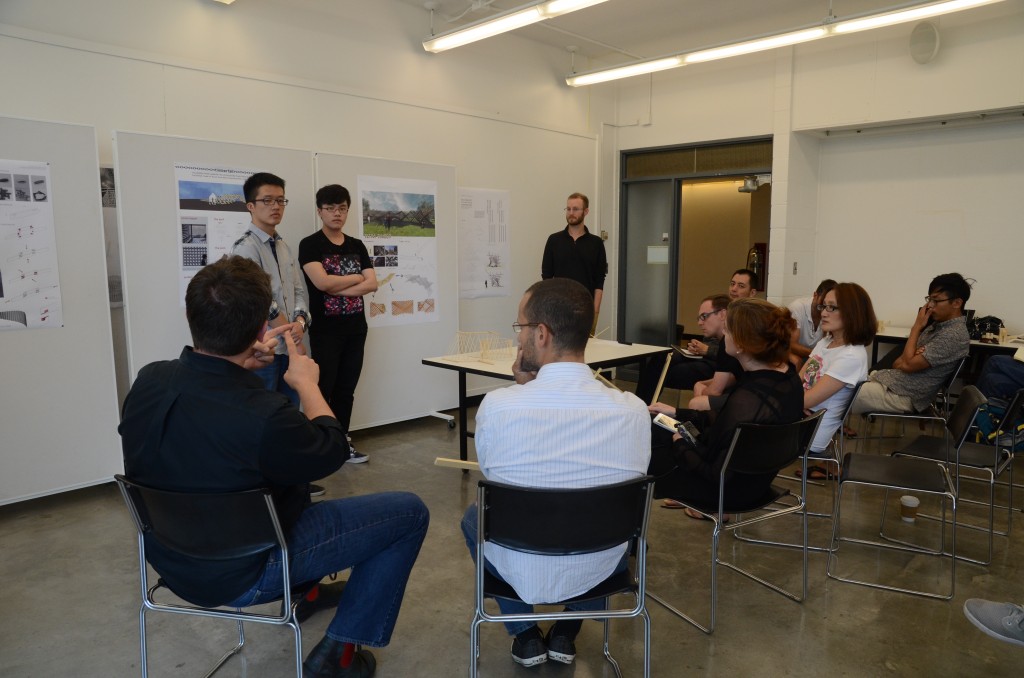Assemblages was a design-fabricate studio taught as a guest professor for South East University with Blair Satterfield in August 2014. Fabrication was completed under the supervision of collaborating professors at Southeast University: Han Xiaofeng , Zhu Lei , Bao Li.
This intensive studio is part of a larger program to reintroduce the top professional architecture schools in China to the use of wood as a structural material. The larger program is an extension of a successful decade long project developed to reintroduce top Universities in China to the use of wood as a structural material. While initially rolled out for engineering schools, the program has now expanded to include architecture schools. The program has been ongoing at top engineering universities in China – Tongji University and SouthEast University – for the last 10 years and is expanding.
Eight teams comprised of 24 students from both schools developed proposals for two unique timber constructs to be cited in Suzhou and Vancouver respectively. The two week course culminated with a competition and public review. A jury of local architects and engineers selected one design appropriate for prototyping and construction at each of the respective sites. Prior to the design phase students had the opportunity to tour award winning wood buildings in Vancouver and Whistler. They also visited local architecture firms and were introduced to the use of digital tools in timber construction at the Centre of Advanced Wood Processing at UBC.
Studio Description
Assemblage is an intensive two-week course that engages students with timber and examines the essential and formative contribution that a rigorous material investigation can bring to architectural design inquiries. The discipline of architecture often derives its purpose and meaning from a large range of considerations, including social and cultural engagements. It then works toward a highly specific material resolution to those considerations. This studio will work in an opposite manner, and will focus first on tectonic and material considerations and then speculate on how those assemblies have impact at the scale of the social.
Assemblage contends that material inquiries can no longer be considered without an understanding of digital methods in architecture. Developing an understanding of the role of the digital in fabrication is becoming critical for all designers. Digital-fabrication methods can and do heavily inform material investigations and assembly. These tools are present at all phases of wood production, from extraction and milling to finishing and joining and tectonic, fabrication, and digital methods are increasingly interdependent. The knowledge of fabrication methods and tools informs the outcome of architectural design.
Material exploration in architecture is an essential part of design investigation. The architect defines and codifies space and experience with material. Developing an understanding of a material, its media, and methods is critical for any designer wanting to impact the built form. The ability to invent with a material is based in part on understanding and experimenting with that material. Throughout history, developments in material technologies have served as catalysts for new languages in architecture. Materials are the medium through which the architect designs, and the ability to manipulate a material’s qualities of texture, colour, light reflectance, order, density of arrangement, permeability, and feel is critical. The use material in architecture goes beyond envelope and structure. Architects deploy material to provide a space with mood, rhythm, and order. Some would argue that the deft use of material has the ability to add meaning to a constructed space.
Wood in China
Timber in China was once part of a developed and sophisticated architectural language. Timber was used in the construction of a variety of building types, including housing and cultural buildings. In recent decades, China has seen a dramatic decline in the use of timber. This change in China’s built material culture has occurred for many reasons. Population growth combined with rapid modernization and expansion has resulted in deforestation and reduced access to wood. Concurrent to this explosion in construction was a shift in social and cultural tastes. The use of timber fell out of favor, often seen as antiquated or unsophisticated. The result was a significant decrease in the use of wood for building in China. This is changing however. Wood has many advantages in construction and architects around the world are engaging this ancient construction material with fresh eyes. Wood and wood products are highly sustainable building materials. Wood stores a significant amount of carbon and is renewable and recyclable. The use of timber further benefits the environment by displacing other materials (concrete, steel) that take significantly more energy to create. Engineered timber products are able to rival concrete and steel in their ability to carry load and span distances. Wood is easy to manipulate and form. It is resilient and flexible. These (and other) benefits combined with a rich cultural history in the use of wood in architecture may mean China is ready to move toward timber again for her architectural applications.
This nexus of historical and technological trajectories combined with the growing availability of wood, prompts Assemblage studio to ask the following questions: What is the new language of timber design in China? Chinese architects are uniquely positioned to re-consider the use of timber in architecture and to develop innovative languages for a new and sustainable material culture. How might the use of digital tools merge with the historic use of timber in China to create a new synthetic language of form and function? What might a resulting timber language be?
Tectonic investigation
One benefit of timber is its inherent beauty. The structure that does the physical work can also be a critical element in the aesthetic expression of the built form. Finding the balance between performance and expression is one primary challenge of the Assemblage studio. This one material becomes a formidable architectural agent: acting simultaneously as the element of spatial definition, structure, and finish.
The Assemblage studio project will challenge students to examine the tectonic aspect of a timber structure using advanced digital fabrication tools. The structural elements and their connections will also be the architectural expression of the final projects. The expression, function, and consideration of joints and assemblages combined with the inventiveness of the design teams in considering these elements will provide value to the project.
Summary of studio intent
The studio will use iterative sequenced projects to acquaint students with timber construction and to speculate on how material logic and applied tool use can contribute both enduring value and meaningful invention within the discipline. The studio is rooted in the premise that a focused material inquiry can result in designs that are experientially and conceptually complex, and both spatially and formally generative.
Students will develop iterative physical models and prototypes at a variety of scales. These will build to a final project that will be built at full scale – challenging and testing the logics and assumptions the design team made during the project’s design phase.
Format
The studio will explore design strategies that address the above objectives. The studio is an intensive material research studio. As such, student work will span from research into the tectonic arrangement of timber assemblies and its detail connections. Iterative smaller scale explorations will be essential investigative tools of the studio. The final product of the studio will be a full (body) scale installation.
Program
The installation at UBC will be in the foyer of the Wood Science department. It is meant to be a showcase structure for the advanced wood fabrication that the department supports.
The installation at SEU will be in the courtyard as per last year’s installation. Design will be rationalized for that location using the material system chosen.


